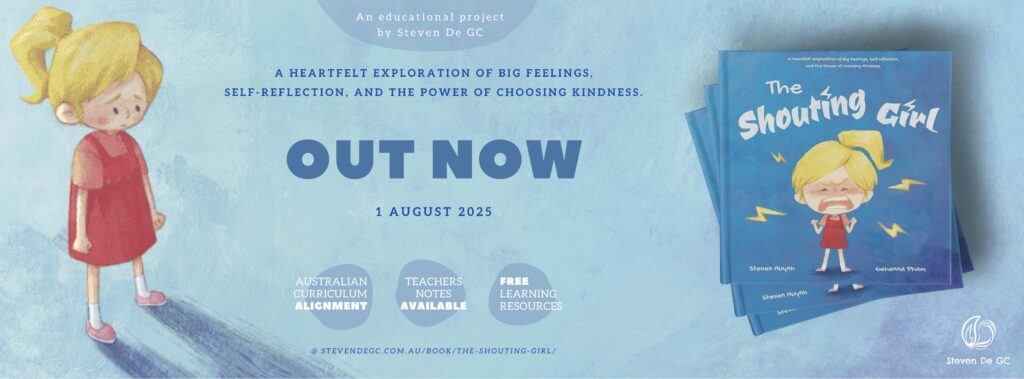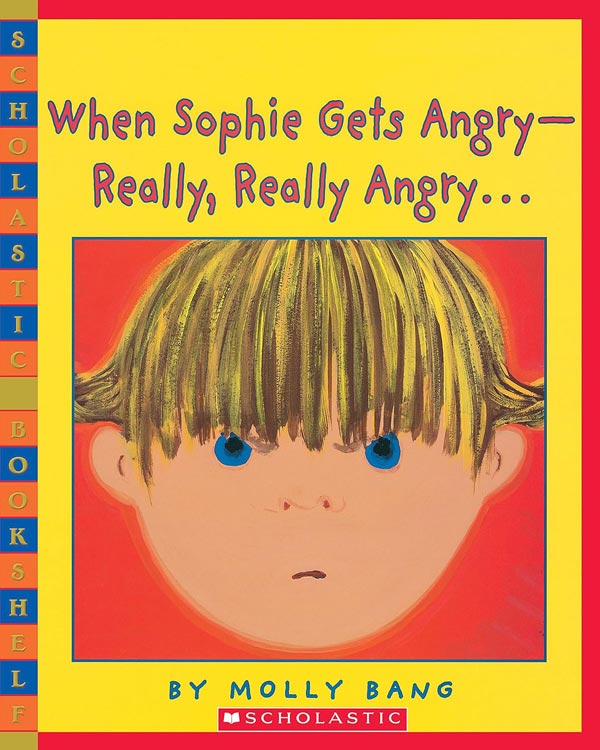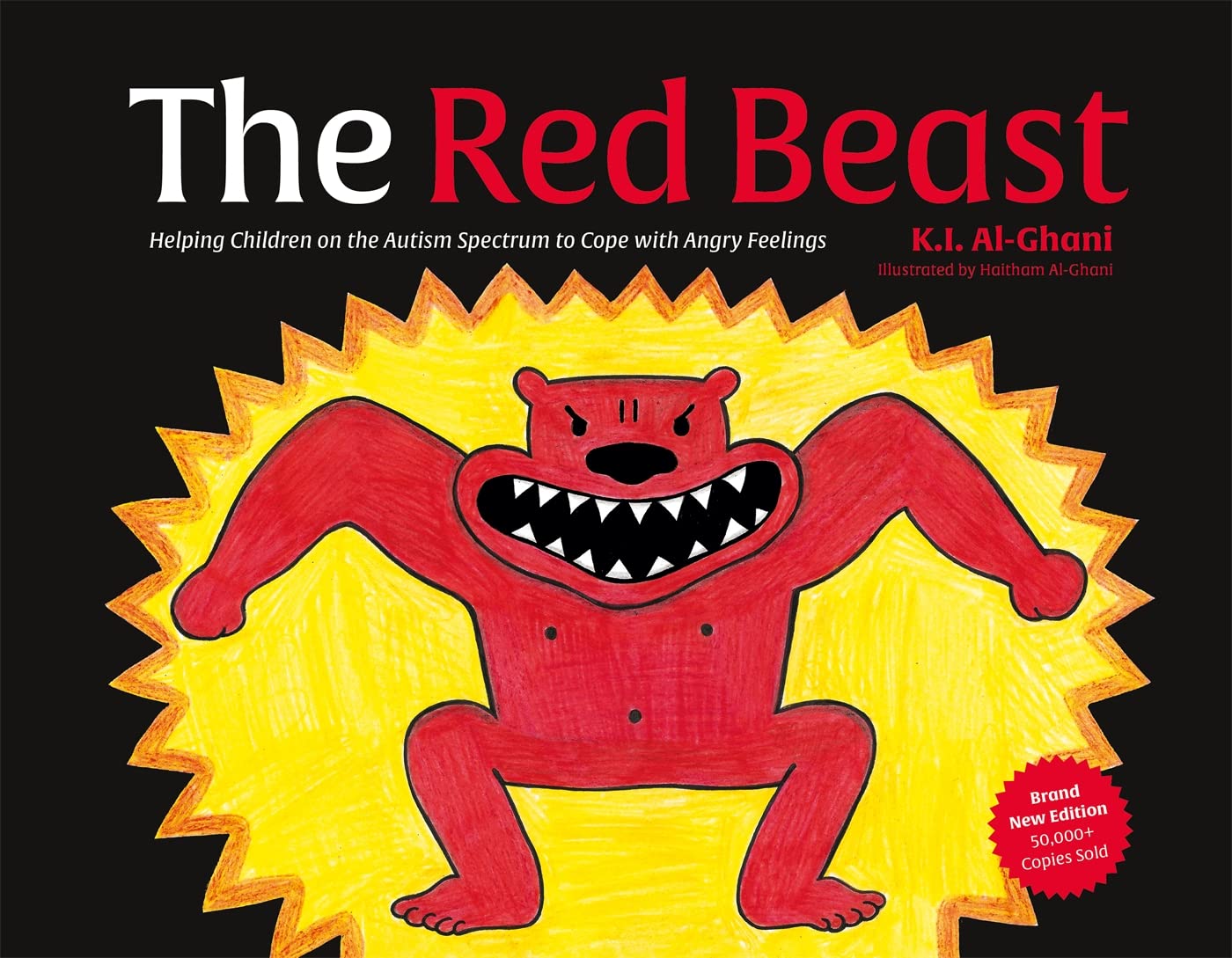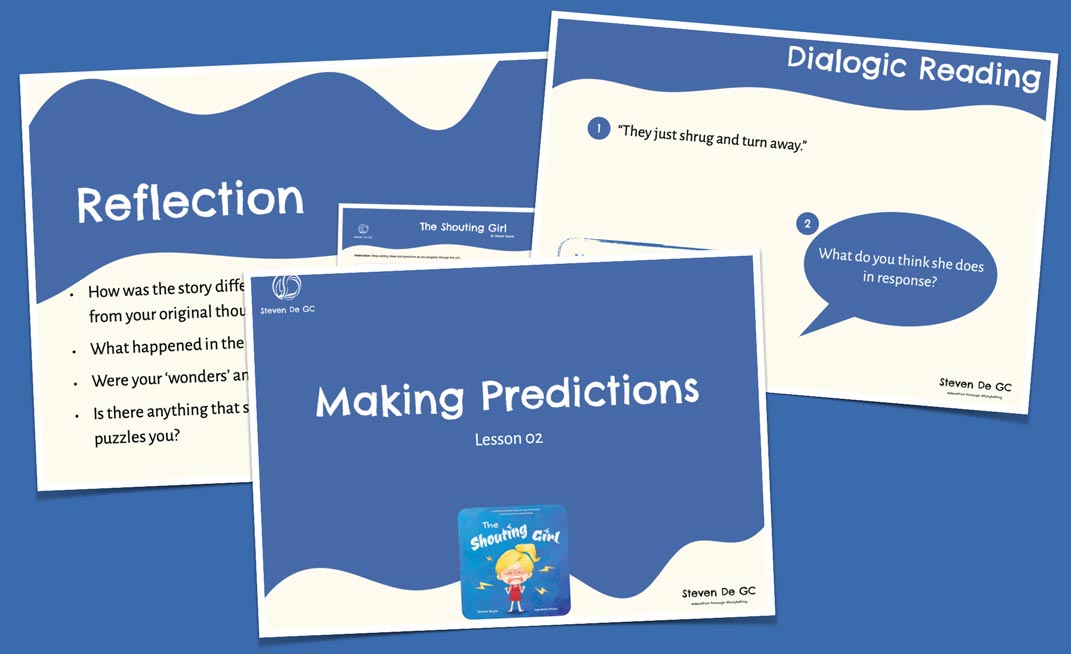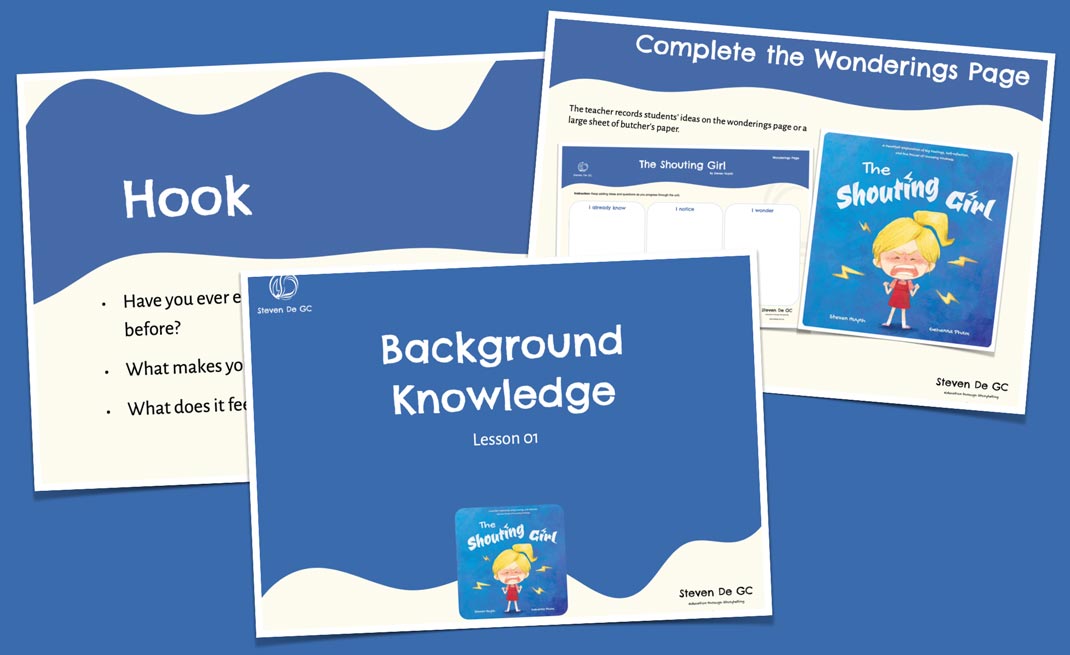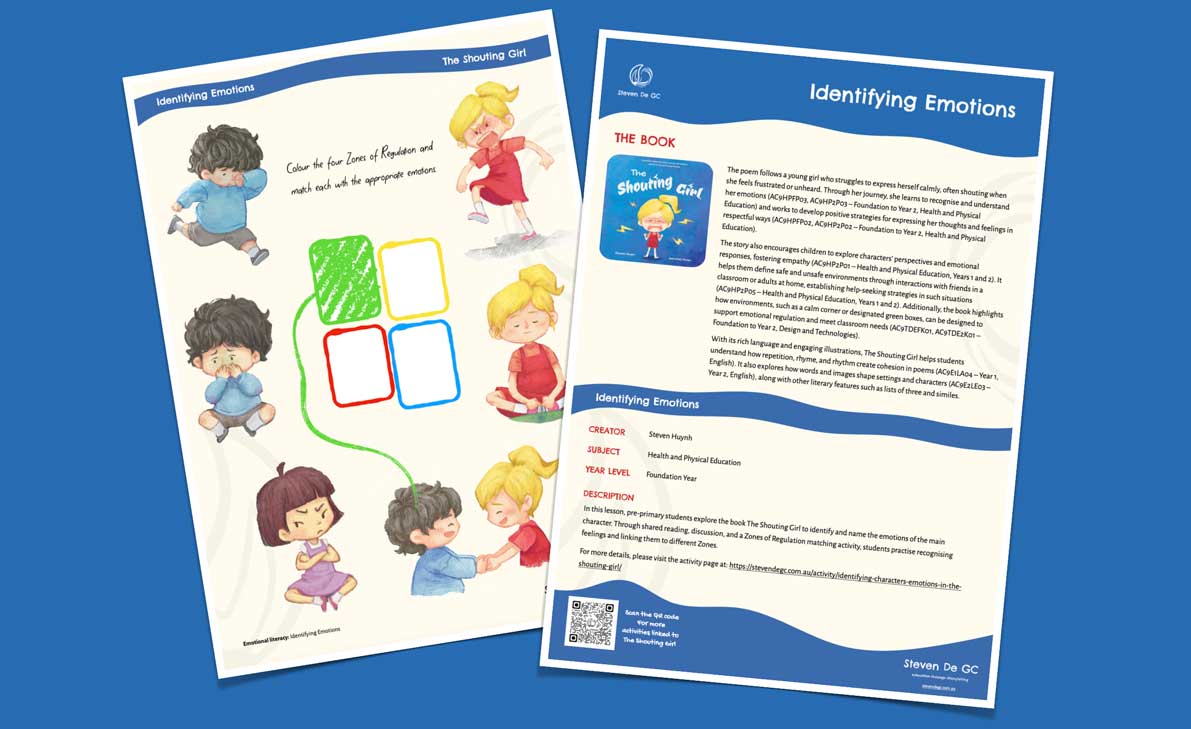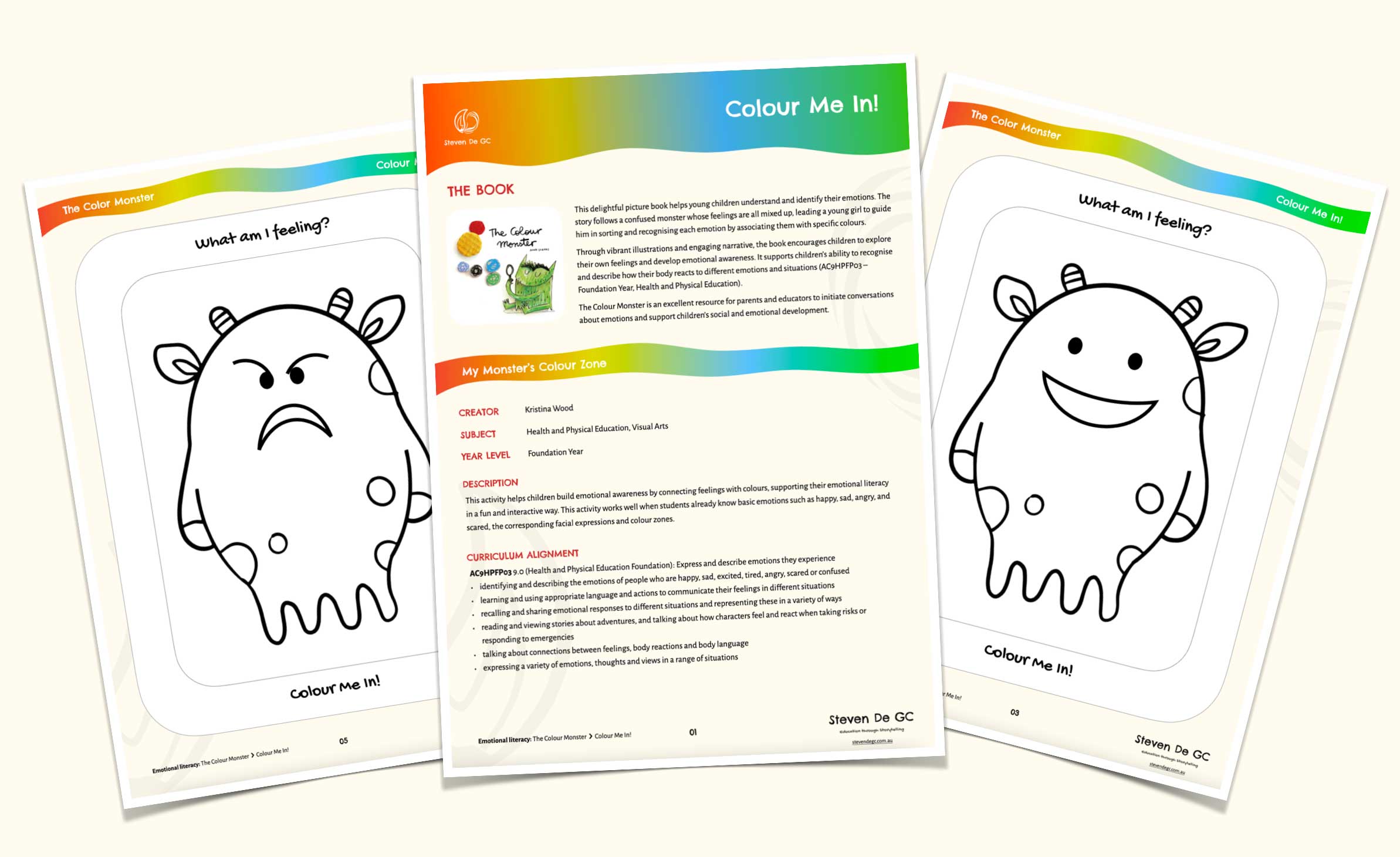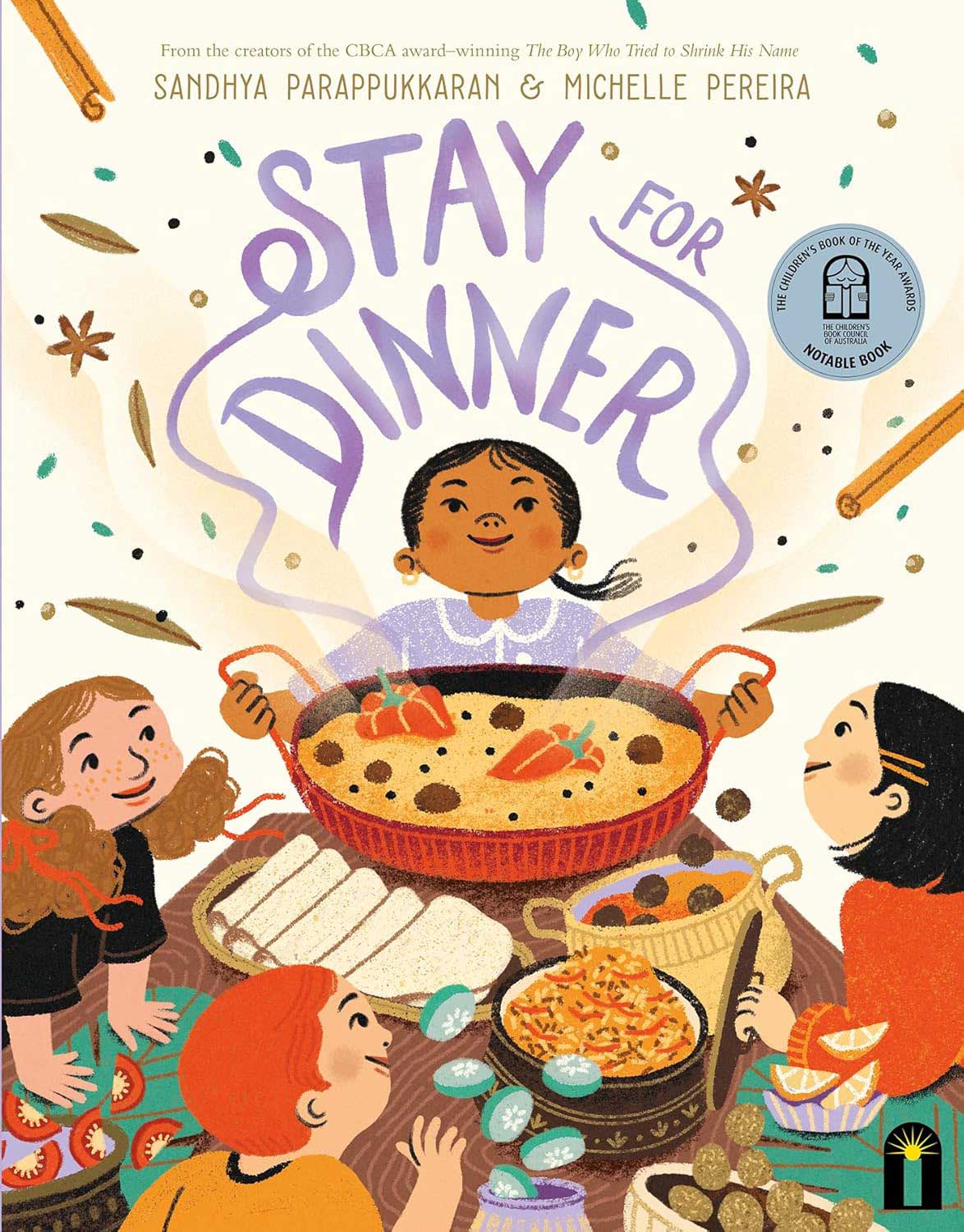Emotion recognition
- This emotion recognition section features books, activities, and articles that support children in recognising and describing emotions—such as feeling happy, calm, sad, angry, scared, or loved. Each resource involves at least one of the following aspects of emotions: body reactions (e.g., stomping, crying, or smiling), emotion-related language (e.g., nice, friendly, or hateful), or actions that express feelings (e.g., hitting, spitting, or playing nicely). Many also include Zones of Regulation tools to help children link emotions to colours and behaviours.
- If you’re looking for strategies to cope with or manage big emotions, please head to our Emotional Regulation section. While some resources overlap, this section specifically focuses on helping children identify and make sense of emotions in themselves and others.
- Most resources align with the Australian Curriculum and are shared as references for educators, parents, and carers supporting Foundation (age 5), Year 1 (age 6), and Year 2 (age 7) learners.
-
How to Discuss Family Tension or Conflicts with Kids
Practical advice for parents to discuss family tension with children and support healthy conflict resolution at home.
-
Recognising Anger With “When Sophie Gets Angry”
📔 When Sophie Gets Angry — Really, Really Angry by Molly Bang• We are learning to recognise emotions by showing how different feelings can look and feel in our bodies and on our faces.
-
When Sophie Gets Angry — Really, Really Angry
Written & illustrated by Molly Bang
Published by Scholastic Press
Theme/topic: Emotion recognition and Emotional regulation
The picture book explores the intense feelings that come with anger and how children can learn to manage them. When Sophie feels overwhelmed, her body reacts in strong and noticeable ways: her face gets hot, her fists clench, and she feels like exploding. This allows students to describe what anger looks and feels like physically (AC9HPFP03 – Foundation Year, Health and Physical Education), helping them recognise emotional cues in themselves and others.
As Sophie removes herself from the situation, takes time to cool down in nature, and eventually returns feeling calm, the story models simple and effective emotional regulation strategies (AC9HP2P03 – Years 1 and 2, Health and Physical Education). These moments provide powerful prompts for children to reflect on their own ways of calming down and regaining control during emotionally charged moments.
When Sophie Gets Angry — Really, Really Angry is a gentle yet impactful resource for developing emotional literacy, supporting children in identifying and managing their big emotions in healthy ways.
The Red Beast
Written by K.i. Al-Ghani
Illustrated by Haitham Al-Ghani
Published by Jessica Kingsley Publishers
Theme/topic: Emotion recognition and Emotional regulation
This powerful story helps children understand and manage anger through the metaphor of a ‘red beast’ that awakens when feelings become overwhelming. The book offers a safe and engaging way for students to explore what anger looks and feels like in the body (AC9HPFP03 – Foundation Year, Health and Physical Education), using clear language to describe both the emotional and physical signs of big feelings.
As the main character learns how to calm the red beast, readers are introduced to strategies for emotional regulation (AC9HP2P03 – Years 1 and 2, Health and Physical Education). The narrative also opens up conversations about how certain behaviours and language can cause hurt and harm to others (AC9HPFP02, AC9HP2P02 – Foundation to Year 2, Health and Physical Education). Through reflection and discussion, children are encouraged to build empathy and make respectful choices in how they express emotions.
The Red Beast is an essential resource for supporting social-emotional learning in early years classrooms, offering practical tools to help children recognise, name, and regulate big emotions in themselves and others.
The Shouting Girl: L2 Making Predictions
📔 The Shouting Girl by Steven Huynh• We are learning to make predictions about the text.
The Shouting Girl – L1 Background Knowledge
📔 The Shouting Girl by Steven Huynh• We are learning to build our background knowledge to help us comprehend a text.
Identifying Characters’ Emotions in The Shouting Girl
📔 The Shouting Girl by Steven Huynh• We are learning to identify how a character is feeling and match emotions to Zones of Regulation.
The Shouting Girl
Written by Steven Huynh
Illustrated by Gehenna Pham
Published by Steven De GC
Theme/topic: Emotion recognition, Emotional regulation, Inclusion, Recount, Rhyme, and Vocabulary expansion
The story follows a young girl who struggles to express herself calmly, often shouting when she feels frustrated or unheard. Through her journey, she learns to recognise and understand her emotions (AC9HPFP03, AC9HP2P03 – Foundation to Year 2, Health and Physical Education) and works to develop positive strategies for expressing her thoughts and feelings in respectful ways (AC9HPFP02, AC9HP2P02 – Foundation to Year 2, Health and Physical Education).
The story also encourages children to explore characters’ perspectives and emotional responses, fostering empathy (AC9HP2P01 – Health and Physical Education, Years 1 and 2). It helps them define safe and unsafe environments, such as calm corners, through interactions with friends in a classroom, establishing help-seeking strategies in such situations (AC9HP2P05 – Health and Physical Education, Years 1 and 2).
With its poetic language and engaging illustrations, The Shouting Girl helps students understand how rhyme and rhythm create cohesion in a text. It also explores how words and images shape settings and characters, along with other literary features such as lists of three and similes.
AC9E1LA04 (English Language and Literacy – Year 1) AC9E2LE03 (English Language and Literacy – Year 2) AC9E2LE04 (English Language and Literacy – Year 2) AC9HP2P01 (Health and Physical Education – Year 1, Year 2) AC9HP2P02 (Health and Physical Education – Year 1, Year 2) AC9HP2P03 (Health and Physical Education – Year 1, Year 2) AC9HP2P05 (Health and Physical Education – Year 1, Year 2) AC9HPFP02 (Health and Physical Education – Foundation) AC9HPFP03 (Health and Physical Education – Foundation)I Have Feelings
Written by Jana Hunter
Illustrated by Sue Porter
Published by Mondo Pub
Theme/topic: Emotion recognition and Emotional regulation
I Have Feelings by Jana Hunter is a sweet story that explores the wide range of emotions children experience. Through relatable scenarios and simple text, the book helps young readers recognise and understand their own feelings, such as happiness, sadness, and anger, and what triggers those feelings. This book serves as an excellent resource to support children in describing and express emotions they experience in an appropriate way (AC9HPFP03 – Foundation Year, Health and Physical Education).
With its vibrant illustrations and engaging narrative, I Have Feelings encourages children to express their emotions in a healthy and constructive way. It provides a perfect opportunity to discuss emotional literacy, social skills, and respectful interactions with peers.
The Colour Monster: Colour Me In!
📔 The Colour Monster by Anna Llenas• Students are learning to develop their ability to identify the colour zone of feelings.
My Monster’s Colour Zone
📔 The Colour Monster by Anna Llenas• Students are learning to develop their ability to identify the colour zone of feelings.
The Colour Monster
Written & illustrated by Anna Llenas
Published by Templar
Theme/topic: Emotion recognition
This delightful picture book helps young children understand and identify their emotions. The story follows a confused monster whose feelings are all mixed up, leading a young girl to guide him in sorting and recognising each emotion by associating them with specific colours.
Through vibrant illustrations and engaging narrative, the book encourages children to explore their own feelings and develop emotional awareness. It supports children’s ability to recognise and describe how their body reacts to different emotions and situations (AC9HPFP03 – Foundation Year, Health and Physical Education).
The Colour Monster is an excellent resource for parents and educators to initiate conversations about emotions and support children’s social and emotional development.
Stay For Dinner
Written by Sandhya Parappukkaran
Illustrated by Michelle Pereira
Published by Bright Light
Theme/topic: Culture, Diversity, Emotion recognition, Identity, Narrative, and Vocabulary expansion
Stay for Dinner by Sandhya Parappukkaran is a vibrant celebration of cultural diversity and the connections made through shared meals. The story centres on a family preparing a special dinner for their child’s friends, offering a glimpse into various mealtime customs and table manners (AC9HP2P01 – Years 1 and 2, Health and Physical Education). Through the lens of this dinner, the book explores the emotional responses and questions that arise from cultural traditions (AC9HP2P03 – Years 1 and 2, Health and Physical Education), encouraging children to embrace diversity and appreciate the richness of different cultural backgrounds (AC9HP2P02 – Years 1 and 2, Health and Physical Education).
The narrative is brought to life with vivid sound and imagery words such as “squish,” “splash,” “slice,” and “prong,” capturing the sensory experience of the meal. Culinary terms like “papadum,” “sadhya,” and “dumpling” add authenticity and depth, inviting readers into the world of diverse cuisines. As the main character reflects on her and her friends’ mealtime experiences, the story underscores the importance of understanding and respecting different customs, fostering a sense of togetherness and mutual respect.
With its rich illustrations and heartwarming themes, Stay for Dinner inspires children to find joy in sharing meals and traditions, highlighting the value of friendship and cultural appreciation.
In My Heart: A Book of Feelings
Written by Jo Witek
Illustrated by Christine Roussey
Published by Abrams Appleseed
Theme/topic: Emotion recognition
In My Heart: A Book of Feelings by Jo Witek is a beautifully illustrated story that explores a wide range of emotions in a way that is accessible to young children. The book follows a young girl as she describes how different feelings manifest in her heart—whether it flutters with happiness, feels heavy with sadness, or pounds with excitement.
Through expressive language and vivid imagery, the book helps children recognise, name, and understand their emotions, supporting their ability to describe how their body reacts to different feelings and situations (AC9HPFP03 – Foundation Year, Health and Physical Education). The engaging die-cut heart illustrations add a tactile element, reinforcing the idea that emotions come in many forms and are a natural part of life. In My Heart is a valuable resource for fostering emotional literacy, encouraging self-awareness, and promoting discussions about feelings in a comforting and relatable way.


